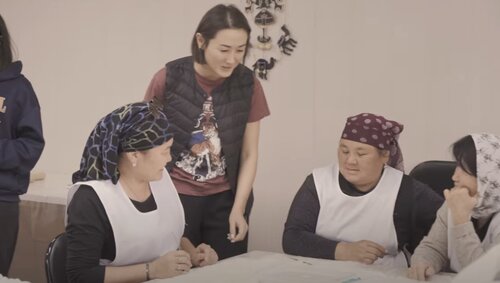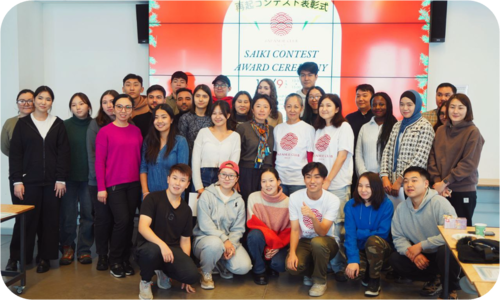- TOP
- 資料館
- FOCUS
- September 2024 - Volume 117
- Students' Engagement with Global Citizenship Education in Kyrgyzstan
FOCUS September 2024 Volume 117
Students' Engagement with Global Citizenship Education in Kyrgyzstan
The One Village One Product (OVOP) movement in Japan started in a rural area of Oita Prefecture in 1961. The vision of the OVOP movement was to increase the income and wealth of local people in the region. OVOP project was developed uniquely for Japan, but adapted later for other Asian countries.
In 2005, Kyrgyzstan revived the basic "unit of local socio-economic activities" established during the time of the rule of the USSR (Union of Soviet Socialist Russia)[1] by enacting the Law on Community-Based Organization (OCB) in February of that year. In light of this, community empowerment and community revitalization became the priorities of Japan's overseas development aid (ODA) in Kyrgyzstan.[2] Japan started to implement development and technical cooperation projects through Japan International Cooperation Agency (JICA) in 2011. The projects became part of the Kyrgyz national project in 2023 and later expanded to other Central Asian countries.
The Course
The American University of Central Asia (AUCA) offers the "International Development and Cross-Cultural Communication" course where students explore Global Citizenship Education (GCED) as a transformative education aimed at building a just, peaceful, tolerant, inclusive, secure and sustainable society. Students learn about the universal principles of GCED: Human Rights, Gender Equality, Non-Discrimination, and Non-Violence and respect for all.
The students study Japan's ODA, JICA, GCED, Gender, Sustainable Development Goals (SDGs) and the New Development Paradigm. They do field work by visiting communities where OVOP projects are being implemented. The field trips (OVOP Study Tour Project) cover the following projects:
- Gender Empowerment
- New Development Paradigm
- SDGs.
Student Activities
Students from Uzbekistan, Tajikistan, Kyrgyzstan and Japan studying the "International Development and Cross-Cultural Communication" course and the AUCA Japanese Club members at American University of Central Asia (AUCA) located in Bishkek city organized field visits in 2023 under the course. They were students from different disciplines such as Liberal Arts and Sciences, Anthropology, Applied Math, Business, and Economics.
The students visited communities with OVOP projects. The field visits allowed the students to gain the experience of seeing theory being translated into practice. The students make videos on the field visits. The AUCA Japanese Club decided to introduce the students' videos on YouTube, www.youtube.com/@japanese_club_auca.
 Student interaction with village felt producers
Student interaction with village felt producers
 AUCA students in the "Saiki" event, December 2023
AUCA students in the "Saiki" event, December 2023
One video entitled "Student's Engagement with Global Citizenship Education through One Village One Product" created by an instructor and an alumnus of AUCA was shared with the university's Instagram channel with almost eleven thousand views.[3]
There are also videos on other OVOP projects including "Saiki" (Let's Revive) event (December 2023) introducing the concept of GCED to around forty to fifty students and four faculty members who participated in this event.[4]
Final Stage of the Project
At the conclusion of the course, a final event titled "Students' Engagement with Global Citizenship Education through One Village One Product (OVOP) in Rural Issyk-Kul, Kyrgyzstan" was held on 9 December 2023.
The event included a presentation on the concept of GCED and the importance of Cross-Cultural Communication (Social-Emotional Domain) presentation. The three videos on the OVOP projects related to human rights were also shown:
- Empowerment of Women in the Issyk-Kul Region;
- Sustainable Development Goals and OVOP;
- New/Alternative Development Paradigms and OVOP.
There were approximately forty attendees in the final event including AUCA faculty, staff, alumni and students, and also students from Kyrgyz National University, Bishkek State School № 70, Kyrgyz State Medical Academy, International University of Kyrgyzstan, and Kyrgyz-Turkish Manas University. Additionally, students created a Kahoot quiz with fifteen questions to test the participants' knowledge. The quiz was well-received, with active participation from all attendees.
This author and her student (Aidaana Khasanova) in AUCA wrote an article about an OVOP project entitled "Living Heritage of Indigo Dyeing as a Bridge between Japan and Kyrgyzstan" that appeared in the Journal of Intercultural Dialogue.[5]
The success of the project motivated this author and the leader of the AUCA Japanese Club to propose its continuation. The planned follow-up will focus on:
As for further improvement of such kind of project, there is a need to provide concrete evidence supporting the OVOP model as an ideal development paradigm. The Alternative/New Development Paradigm Group could have made such presentation. Thus, this author should continue to explore and identify critical perspectives to enhance the understanding of this model.
Conclusion
Students who participated in the course paid attention to the challenges that Kyrgyzstan faces regarding women by learning about gender, the reality that women face every day at OVOP workplace, the relationship of OVOP to the SDGs, and how OVOP local producers' conditions lean toward Alternative Development Paradigm.
Students were excited in finding out that there were young adults who work as felt producers. Since OVOP started in 2011 until now, the number of felt workers exceeded two thousand around the Issyk-Kul area. This means that women started to earn money and elders are encouraging young women to work. Surprised at two young felt producers who showed that they were self-sufficient, the students gained self-confidence.
Students acknowledged the empowerment of women through small-scale business in the villages of the Issyk-Kul region. The video produced by the students points out the patriarchal society in Kyrgyzstan and women have to work under certain situations. Aware of the situation, OVOP allows women to work at home on flexible working hours. The video also points out the lack of opportunities for workers to access medical insurance, pension funds, and basic economic opportunities. The people implementing OVOP acknowledge the need to improve the project in some areas as part of their agenda.
Students who joined the OVOP fieldwork discovered personal and social tolerance. Coming from different cultures and being together in the field work made them realize something about their own selves and others. They learned differences in values, customs and behavior of people.
Students learned global citizenship through OVOP community-based project and realized the importance of sense of humanity at personal, local and global levels.
Yumi Takahashi is a member of the Faculty of Anthropology and the International Development Program in the American University of Central Asia in Bishek, Kyrgyzstan.
For further information, please contact: Yumi Takahashi, Faculty of Anthropology, American University of Central Asia, e-mail: myumi7635@gmail.com.
[1] See Yukimi Shimoda, "Unpacking the Influence of Business Approaches to Development on the Expansion of Women's Choices and Empowerment: A Case Study of a Handicraft Business in the Kyrgyz Republic," Working Papers 231, JICA Research Institute, 2022, https://jicari.repo.nii.ac.jp/?action=repository_uri&item_id=1086&file_id=22&file_no=1.
[2] See Bobur Nazarmuhamedov, "Japan's ODA Policy toward Central Asia and the Caucasus: An Analysis of Japanese Assistance to Economic Development in Kyrgyzstan and Armenia," Journal of International and Advanced Japanese Studies, Vol. 10, 169-185, 2018, https://tsukuba.repo.nii.ac.jp/record/46379/file_preview/JIAJS_10-169.pdf
[3] See Instagram, www.instagram.com/reel/C4XhaaQOzYl/?igsh=MWp4NDF0OTk3eGtrNQ==.
[4] Watch "'Saiki' Contest as a Bridge between Kyrgyzstan & Japan (through Experiential Learning & GCED)," www.youtube.com/watch?v=redY7CpEj-4.
[5] See IISNC-UNESCO, https://online.fliphtml5.com/sedrz/ahul/#p=1.
[6] Kaizen is a Japanese term meaning "good change," "change for the better," or "improvement." See Kaizen: The Culture of Continuous Improvement, Safety Culture, https://safetyculture.com/topics/kaizen-continuous-improvement/
[7] See Viktoriya Kuzina, Hou-Ren-Sou: Three Whales of Japanese Business Communication World, SME Japan, www.smejapan.com/business-news/ho-ren-so-three-whales-of-japanese-business-communication-world/.
[8] 5S methodology refers to Seiri (Sort), Seiton (Set in Order), Seiso (Shine), Seiketsu (Standardize), and Shitsuke (Sustain). See Luciana Paulise, Implementing Effective Workspaces with 5S Methodology!, Simpli Learn, 6 June 2024, www.simplilearn.com/implementing-5s-methodology-to-achieve-workplace-efficiency-article.
